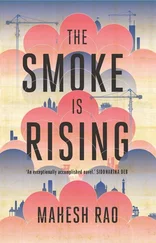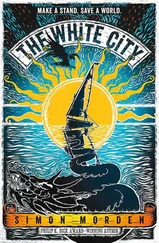Whenever the futility lay too heavily upon me, I got out my designs for the second series of DARE . The sad fact was, Stella, my first client, was likely to be my only client for some while, and if I wanted to stay in London, then the only way forward for me was to do the kind of work she had offered to find for me: concept artwork in television and film. DARE ’s balsa-wood moonbase and extruded polyethylene submarine were amusing enough, and I had undeniably enjoyed designing and assembling them. Series two was already well into development, and I was having a lot of difficulty trying to dream up suitably otherworldly shapes for the aliens’ lunar beachhead, an important recurring locale. Stella had so far deemed everything I had sketched ‘too tellurian’.
‘Too what?’
‘Too Earthlike, dear.’ She poured out more tea. ‘Too grounded , somehow. I don’t know. I mean, what do we really know about these aliens?’ She gazed off into the Barbican Centre café’s bright orange middle distance.
Now that my work for DARE involved maquette-making as well as sketching, Stella was renting space for me in the Barbican itself, in workshops that were meant to serve the theatre in the art centre’s basement.
Being handed the keys to these well-appointed workshops sped my work along. It meant I could walk to work in minutes. It also meant Stella had an excuse to call in at our flat with Betty. Fel, hearing the bell, rushed to the door. It was a novelty for her, to have friends surprise her in the day. Such casual arrangements must, I suppose, have been absent from her own carefully invigilated childhood. And she adored Betty. She scoured charity shops for cast-off toys and games. They were the only second-hand items Fel ever let through our door, and she filled the flat with them. Wooden train sets. Dollies. Toy xylophones. There was always something new at our flat for Betty to play with.
It was strange watching Betty and Fel playing together on the living-room rug, and impossible to say who was humouring whom. Fel talked a good game, always couching her charity-store purchases of toys and games in terms of Betty’s locomotor development, her hand-eye coordination and so on. When they got together, Fel played with Betty the way I imagine she would have played with any toddler. My mother’s uncanniness did not seem to disturb her at all. It made me wonder if Fel had ever played with young children before. Could she simply not see that there was a difference here? A weirdness?
Betty did not so much play with Fel as play along. The Process had her growing so fast you could practically hear her creak, and her mental development was more advanced every time I saw her. By the time my finals were over she had begun speaking: a curious, very unchildlike honking from the back of her throat, all hard ‘g’s and aspirants, as though she were suffering from a bad cold. But she never spoke to Fel except through the sign language that had served her in her first month. It was as if she didn’t want to break the illusion of babyhood. As if, around Fel, she wanted to stay a child.
Betty liked having Fel make a fuss of her. Day after day of Stella correctly and assiduously treating her like an adult undoubtedly made Fel’s attentions, by contrast, into a sort of holiday.
More than that, though: I think Betty genuinely liked Fel. Among the many exasperated glances Betty shot her when she thought Fel wasn’t looking, there were other, much softer, much more melancholy expressions. Once, I came in from a morning at the workshop and found Fel and Betty sitting on the floor, some sort of bead game spread out between them, with their foreheads pressed together. Neither spoke or let my appearance disturb them.
Then Fel was up on her feet asking me how the lunar beachhead was coming along, and Betty, in a striped jumper with buttons at the neck and red rompers and one shoe, was looking up at Fel with an expression, on that unformed toddler’s face of hers, of what I can only call love.
* * *
As that summer ended, so the distinction between the two parts of London – the East and West, the Bundist and the unaccommodated – grew ever more visible.
The Bund’s soft annexation of South East London was an injury to the whole so huge and so sudden – the quick hacking-off of a limb – that the unaccommodated city, still dizzy, incredulous and drunk on the endorphin high of injected capital, was only now waking to the pain of its mutilation.
At the end of a working day, I would stretch out by walking east, into the Bund. With a new phone to help me (‘Here,’ Fel said, handing it to me, ‘it’s simple. There’s only one button,’ – as if that wasn’t half the problem), I decided I would conquer my dislike of exercise and wove a route – never the same twice – to the river, and watched commuters piling home, ever more exhausted, ever more pale and wraithlike, onto ferry boats at Canary Wharf and Millwall Outer Dock. I would ride back with them as far as the Tower. It struck me that my fellow commuters – guest workers, visiting the Bund by day from the unaccommodated half of the city – were beginning to resemble ever more closely the dead-eyed drones drawn by the more hostile newspaper cartoonists. Half-men. Robots. Indentured labour. Working conditions in the Bund remained excellent; in fact, if anything they were improving, with more allowances made for unaccommodated ‘guests’. But something had changed. Watching them stumble off the jetty at the Tower and Charing Cross, you would be forgiven for thinking they had just been hauled, blinking, from the airless depths of a mine. It was hard not to read buyer’s remorse into the blank looks they gave the Thames’s southern banks. Not that there was anything for them to see there. Those zones of the city were by now entirely transmuted, all fairy glitter and constructivist gesture. Structures – you could not call them buildings; for a start, they had no doors – rose and fell there in real-time. There was no solid building anywhere. The very substance of the place had been turned from architecture into something very like metabolism.
In the newspapers, columnists all of a sudden found themselves reminded of the South London of their youth. School nature walks on One Tree Hill. A favourite aunt in Peckham. A visit to the Horniman Museum. The taste of jam fresh from the factory in Deptford. The smell of leather clinging to the maze of little streets in Rotherhithe. Where, the opinion-writers asked rhetorically, had all this past got to? Was it possible that it was gone for ever, transmuted into a dramatic yet finite flow of capital investment? Had the city’s appetite for new construction become so overpowering that it had induced us all to gobble up our past?
It became the fashion, even among those snobs who had never set foot south of the river, to claim some connection with those lost lands. Gift shops sold old postcards of the area, antique advertisements from businesses long dead, road maps that no longer squared, in any particular, with the area they once covered. Between cushions printed with photographic renderings of wide, empty, untarmacked high roads in Brockley and Sydenham sat scale models of the Crystal Palace, the TV transmitter, the full-size plaster dinosaurs grazing in the nearby park. A flyer arriving in our postbox invited us to subscribe to a heritage project: the accurate, brick-by-brick reconstruction, in a derelict corner of Hackney, of Brockley’s demolished Rivoli Ballroom.
Such cheap nostalgia would most likely have faded and been forgotten, were we not constantly reminded of our territorial loss by changes within the Bund itself. Compared to the baffling erasures to the south, the changes wrought in the city’s old financial centre were, on paper, relatively modest. And something had needed doing. Over the few short years of its habitation, the Bund had grubbed up London’s old, war-damaged financial district and amalgamated the pieces into towers like the building-block constructions of a hyperactive child: here a brick-clad wall; there a glass curtain; over there a virtually windowless obelisk. The district’s ancient street plan had not been obliterated so much as upended. Vertical thoroughfares wove through its towering and peculiar constructions, along suspended glass tunnels, over footbridges and platforms, up escalators and moving walkways, so that navigation – already notoriously difficult for the unaccommodated visitor – had begun to tax even the people of the Bund. Some general solution was needed: a way to tie together all these pavements and public spaces.
Читать дальше












